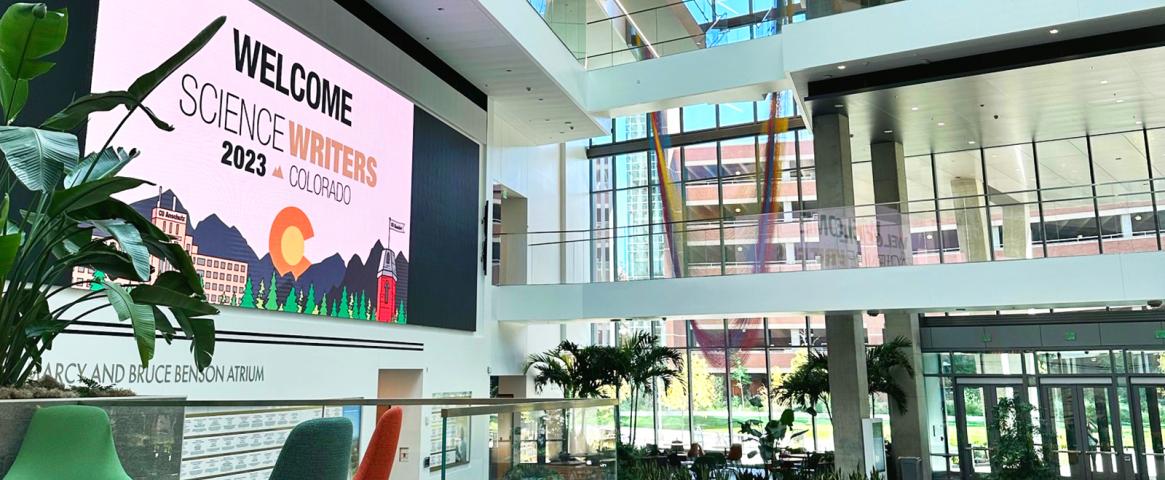Story by Alla Katsnelson
As the immediacy of COVID-19 fades from the headlines, it’s easy for journalists to assume that the pandemic beat is wrapping up. But as three panelists at the ScienceWriters2023 national conference made clear, much vital reporting remains to be done to convey how Long COVID impacts individuals and communities.
Speaking on the “Long COVID – What’s the Story Going Forward?” Science + Science Writing session convened by CASW, panelists said the media must do a better job reporting on how Long COVID affects individuals and communities. The panelists, all of whom have been disabled by Long COVID since the first few months of the pandemic in 2020, began by describing how reporting on the topic has fallen short.
Chimére L. Sweeney, a Long COVID storyteller and advocate, said that her experience with the disease has been marked by racism and misogyny, which was mirrored and reinforced by the media. Sweeney chose to speak widely about her experience as a Black woman with Long COVID in order to counteract the silencing she experienced, and thereby to help women of color feel represented in the healthcare landscape. Although communities of color were disproportionately impacted by COVID, it wasn’t until three or four months into the pandemic that Sweeney saw a Black person on the news, she said. And similarly, although Black and Latino people are disproportionately affected by Long COVID, it took two years for data demonstrating this ethnic breakdown to be publicly released, she said. “The media has a default setting of whiteness,” Sweeney said.
Fiona Lowenstein, a freelance writer, speaker, and consultant and editor of the book The Long Covid Survival Guide, added further critique. The media’s common assertion that Long COVID is a condition that only lasts for just months, while labeling its causes as “mysterious” — a word that often crops up in headlines about the condition — have been harmful, they said during the panel. Some people experience improvement, Lowenstein said, but many remain sick three years on. And the condition is not actually that mysterious: Long COVID is certainly not the first temporarily or permanently disabling condition to crop up after a viral infection, Lowenstein noted. Many people infected by an earlier coronavirus, which caused SARS, experienced similarly debilitating effects. And, of course, myalgic encephalomyelitis, also called chronic fatigue syndrome (ME/CSF) causes a similar disabling condition.
Indeed, said Julia Moore Vogel, who manages the National Institutes of Health’s All of Us Research Program, reporters often overlook the fact that Long COVID is surprisingly common. According to the Centers for Disease Control and Prevention (CDC), 6% of U.S. adults currently have Long Covid, and more than 25% of them experience “significant activity limitations” — and many studies have characterized the condition, based on both patient experience and underlying biology. One complication, she says, is that more than 200 symptoms are associated with Long COVID. “That makes it really difficult for physicians to recognize it, but also for people to recognize it in themselves,” she says. Additionally, “there was never an adequate conveyance of the risk of Long COVID.”
To report more deeply on Long COVID, journalists must invest time into speaking with people disabled by the condition and understanding their lives and perspectives, the panelists said — and not just tack people with the condition onto the end of a story. To account for limited energy levels, journalists should be open to a variety of accommodation requests and interview formats. Some people may prefer audio or Zoom, while others might do better with written responses or exchanges of voice messages.
Regardless, you’ll most likely need to build in more time than usual to engage with sources, the panelists advised. Additionally, many people with Long COVID have memory issues, so if you follow up with questions or fact-checking after a lag, provide extra context to make your request easier to grasp. Also, be sure to contextualize questions you pose during fact-checking. For example, asking someone with Long COVID whether they were ever formally diagnosed with COVID can feel extremely dismissive — especially considering that early on, COVID testing was sparse.
- Tipsheet accompanying the Long COVID Science + Science Writing session (Google Doc)
- Watch the video recording of this Science + Science Writing session convened by CASW and NASW (YouTube)
Reporters should also differentiate between people who are professional Long COVID advocates and those who have the condition. The former will have experience engaging with medical professionals, media, and government agencies that the latter will not have. “Using a professional advocate to illustrate a story about the typical Long COVID experience is not particularly accurate,” said Lowenstein.
It is crucial for reporters to reach out to communities that are often overlooked, panelists said. “We need stories about people who don’t have regular access to health care, people who are undocumented, people who don’t get paid time off,” said Lowenstein. Sweeney noted that Black women are often the providers for their families, so if the reverberations stemming from their disability by Long COVID goes deep. “If I lose my $40,000 salary, and I go home to kid and this rising cost of living, what the hell happens?” she said. “We have to be willing to reach out and to truly follow these people and tell those stories.”
The panelists outlined some areas where nuanced, in-depth reporting about Long COVID is much-needed. Journalists should focus on the entire “ecology” of someone disabled by COVID-19, exploring the condition’s impacts on family members and community from different angles — psychological to financial, Sweeney said. An important topic to explore is how being a person of color intersects with having this disability, she said. Stories about why people who don’t have Long COVID should still consider taking precautions to avoid getting COVID, and stories about how to support people who do have Long COVID, are also important, said Moore Vogel.
Many stories about the biology of Long COVID, its intersection with ME/CSF, and clinical trials exploring treatments remain to be told, Moore Vogel said. “The spectrum of severity” is another area that deserves scrutiny, Lowenstein added.
Covering sociological dimensions of this disease are important, the panelists emphasized. The intersection between Long COVID and labor is also underexplored by reporters. One aspect is the labor shortage — more than a million workers are thought to have dropped out of full time employment due to Long COVID. Another is the impact of Long COVID on healthcare workers in particular. Another important story, highlighted by an audience member, is allyship. Lowenstein noted that one angle is why there has not been a larger groundswell of support for Long COVID-related disability, mirroring movements like HIV/AIDS activism in the 1980s and 1990s or sexual assault survivorship.
“It’s time to turn the page and tell real stories about treatment, research, and the humanistic side” of Long COVID,” Sweeney said.
Alla Katsnelson (www.allakatsnelson.com) is a science writer and editor based in Western Massachusetts.
Tipsheet courtesy of Amber Dance/CASW, compiled from panelists Sweeney, Lowenstein, Moore Vogel.
This ScienceWriters2023 conference coverage article was produced as part of the NASW Conference Support Grant awarded to Katsnelson to attend the ScienceWriters2023 national conference. Find more 2023 conference coverage at www.nasw.org
A co-production of the National Association of Science Writers (NASW), the Council for the Advancement of Science Writing (CASW), University of Colorado Boulder, and the University of Colorado Anschutz Medical Campus, the ScienceWriters2023 national conference featured an online portion Sept. 26-Oct. 3, followed by an in-person portion held in Boulder and Anschutz, Colo., Oct. 6-10. Learn more at www.sciencewriters2023.org and follow the conversation on social media at #SciWri23
Credits: Reporting by Alla Katsnelson; edited by Ben Young Landis. Photography courtesy of Christina O'Haver; edited by Ben Young Landis.


